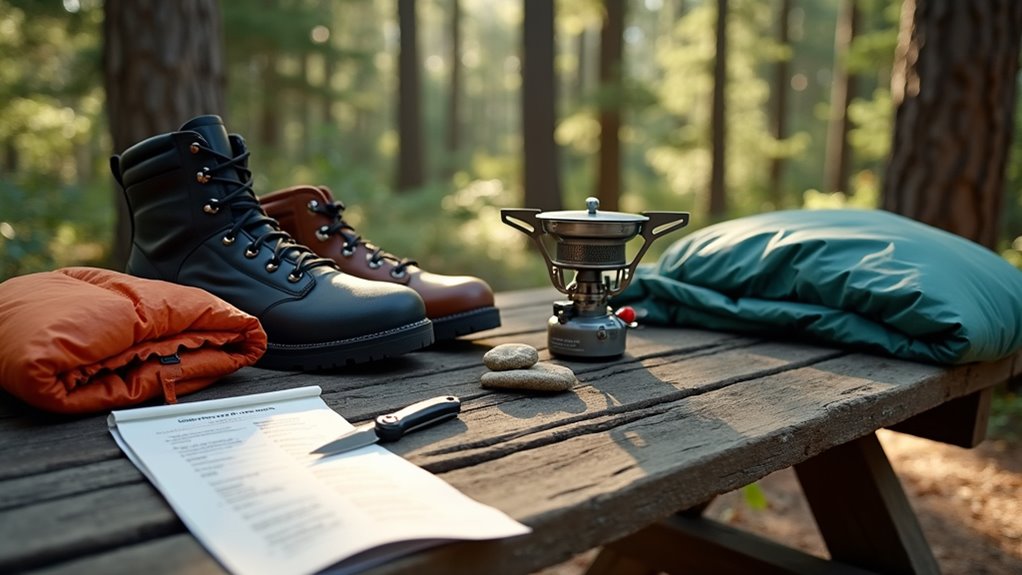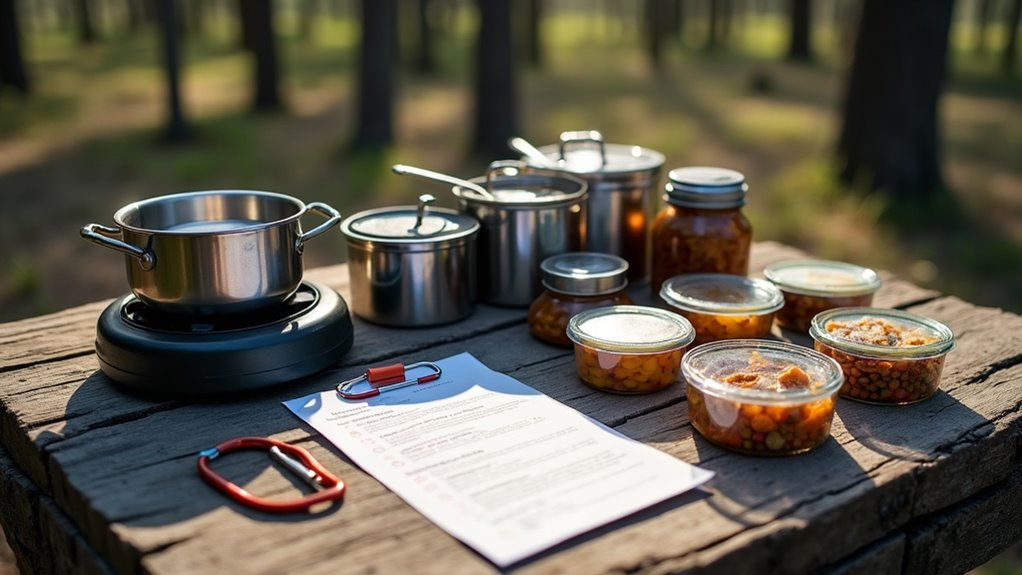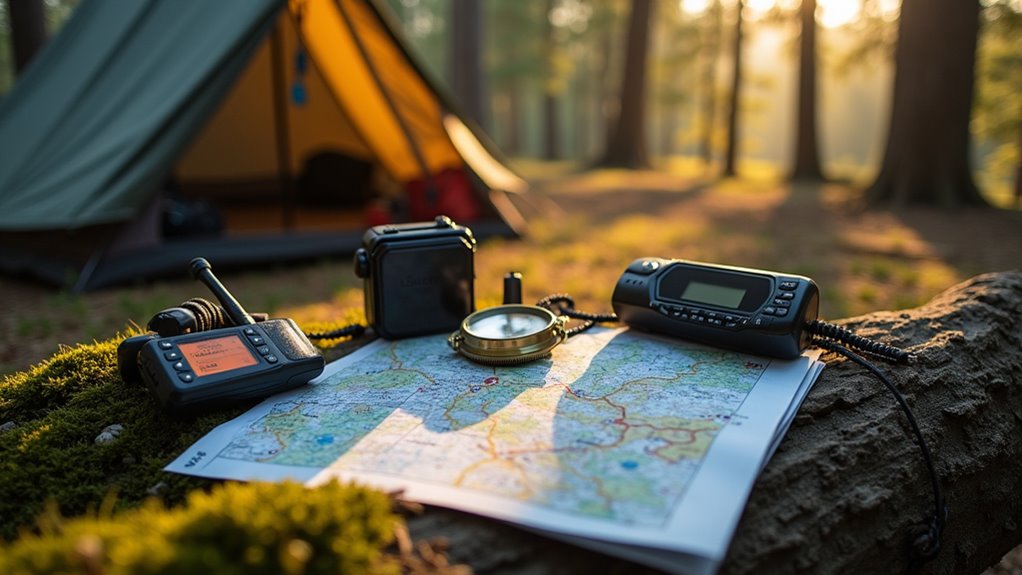Physical Address
304 North Cardinal St.
Dorchester Center, MA 02124
Physical Address
304 North Cardinal St.
Dorchester Center, MA 02124

Never risk a ruined camping trip due to forgotten essentials—discover the simple checklist strategy that prevents dangerous oversights in the wilderness.
You’ve probably experienced that sinking feeling when you’re miles from civilization and realize you’ve forgotten something vital. Whether it’s your headlamp batteries, rain gear, or that essential first aid kit, missing gear can transform an exciting adventure into a dangerous situation. Smart campers know there’s one simple tool that prevents these costly oversights and keeps you safe in the wilderness. The solution isn’t expensive equipment or years of experience—it’s something far more straightforward.

Three vital safety items can mean the difference between a memorable adventure and a dangerous situation in the wilderness. You’ll need an all-encompassing first aid kit containing bandages, antiseptic wipes, pain relievers, and any personal medications. Don’t skimp on quality here—your health depends on it.
A quality first aid kit isn’t optional gear—it’s your lifeline when wilderness adventures take an unexpected turn.
Pack a reliable flashlight with extra batteries, plus a backup headlamp. You can’t predict when you’ll need illumination for emergencies or unexpected nighttime activities. LED options offer the best battery life and brightness.
Include a whistle for signaling help if you’re lost or injured. It’s louder than your voice and requires less energy.
Add a multi-tool with knife, scissors, and pliers for repairs and food preparation. Finally, bring emergency shelter like a space blanket—it’s lightweight but provides essential warmth retention.
If your camping trip includes winter fishing activities, pack appropriate cold-weather gear to maintain body temperature during extended periods by the water.
When temperatures drop and weather turns unpredictable, your shelter and sleep system becomes your lifeline against the elements. You’ll need reliable gear that keeps you warm, dry, and comfortable throughout the night.
Your core shelter and sleep components include:
Don’t overlook tent stakes, guylines, and repair tape for your shelter. Test your entire sleep system at home before heading out. You’ll sleep better knowing everything works together properly.
For those planning caravan camping adventures, ensure your shelter setup is compatible with campground layouts and provides easy access to your vehicle for convenience and safety.

After securing your sleeping arrangements, you’ll need reliable cooking gear to fuel your outdoor adventures. Your camp stove should match your group size and cooking style—lightweight canister stoves work well for backpacking, while car campers can use larger propane models. Don’t forget extra fuel and a windscreen for efficiency.
Pack essential cookware: a lightweight pot set, spatula, and camping utensils. A sharp knife and cutting board make meal prep easier. Include plates, bowls, and insulated mugs for each camper.
Food storage requires airtight containers to prevent spills and pest intrusion. Bring a quality cooler with ice packs for perishables, and store dry goods in sealed bags or containers. Pack a trash bag and biodegradable soap for cleanup—leaving no trace protects the wilderness. Don’t overlook warm bags for storing hot beverages and keeping cooked meals at safe temperatures during cold weather camping trips.
While weather can change rapidly in the wilderness, proper clothing layers will keep you comfortable and safe throughout your camping trip. You’ll need versatile pieces that adapt to shifting conditions without weighing down your pack.
Adaptable layering systems protect against unpredictable wilderness weather while maintaining pack efficiency and mobility throughout your outdoor adventure.
Your essential clothing checklist should include:
Don’t forget a warm hat and gloves, even during summer trips. Mountain temperatures drop considerably at night.
Pack one extra set of everything in case your primary clothing gets wet or damaged unexpectedly.
Desert environments require special attention to clothing choices since temperatures can fluctuate dramatically between scorching days and surprisingly cold nights, making proper layering systems essential for comfort and safety.

Beyond keeping yourself comfortable and protected, you’ll need reliable tools to navigate unfamiliar terrain and maintain contact with the outside world. Pack a detailed topographic map of your camping area and a compass that doesn’t rely on batteries. GPS devices work great as backup navigation, but they can fail when you need them most.
Don’t forget a whistle for emergency signaling – three sharp blasts is the universal distress call. A fully charged cell phone in a waterproof case provides communication when there’s service. Consider a satellite communicator or personal locator beacon for remote areas where cell towers don’t reach.
Download offline maps to your phone before leaving civilization. Test all electronic devices beforehand and bring extra batteries. Before finalizing your navigation gear, make sure to evaluate what camping style best suits your experience level and destination requirements.
Once you’ve gathered all your essential gear, creating a systematic organization strategy prevents last-minute scrambles and forgotten items. You’ll want to establish a method that works consistently for every camping trip.
Start by organizing your checklist into logical categories that match how you’ll pack. Here’s an effective approach:
Don’t forget to include personal hygiene essentials like camping showers to maintain cleanliness during your outdoor adventure. Print your finalized checklist and keep it accessible. You’ll save time, reduce stress, and guarantee nothing important gets left behind on your adventure.
Picture yourself confidently setting up camp as golden sunlight filters through towering pines, knowing you’ve got everything you need. Your checklist’s guaranteed you won’t be scrambling for a flashlight when darkness falls or realizing you’ve forgotten your rain jacket as storm clouds gather. You’ll sleep soundly in your properly equipped tent, wake to a hot breakfast cooked on reliable gear, and navigate trails with confidence. That’s the peace of mind proper preparation delivers.